Peter Cawdron's Blog, page 5
March 19, 2021
Chariot of the Gods?
As a science fiction writer that’s penned 17 novels about First Contact, you’d be hard-pressed to find someone more interested in the possibility of extraterrestrial intelligence than me, but I’ll tell you ʻOumuamua is not alien.

In October 2017, Robert Weryk used the Pan-STARRS telescope at Haleakalā Observatory, Hawaii to observe the first indisputable extra-solar object to enter our solar system. He called it 1I/2017 U1 ʻOumuamua, which is Hawaiian for ‘scout,’ meaning ‘reaching out in advance.’
This is what he saw.

Yep. That’s it. That’s ʻOumuamua. Every other image you’ve seen is an artist’s rendition.
Oh, now that NASA’s had time to properly analyze the data, they’ve revised the dark cigar in favor of this next image, although the pancake is probably not going to be as popular as the cigar, and herein lies the problem—science isn’t a popularity contest.

Science is very good at teasing out an astonishing amount of information from the slimmest of leads, but it takes painstaking patience and diligence to ensure accuracy. When it came to ʻOumuamua, NASA was able to track its path through the solar system.
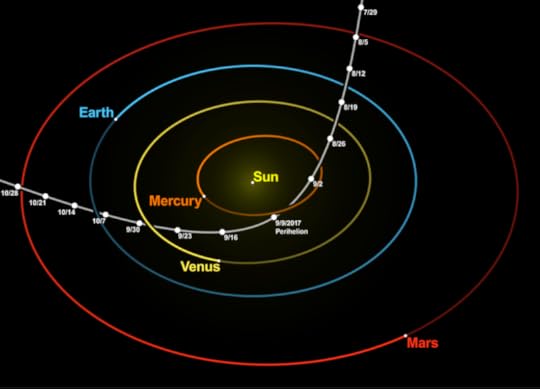
Seeing something from outside our solar system inevitably raises the question of aliens. Was this an extraterrestrial spacecraft? Prominent astrophysicist Abi Loeb thinks so, but he’s missing a teeny tiny thing called evidence. Loeb wrote a best-selling book called Extraterrestrial, which has a rating of 4.4 stars over almost a thousand reviews! Unfortunately for Loeb, science isn’t interested in a book’s rating.

I too want to believe, but based on good science using on empirical evidence, not warm fuzzy feelings.
Let’s look at a few quotes from Loeb’s book.
“The search for extraterrestrial life has never been more than an oddity to the vast majority of scientists. To them, it is a subject worthy of, at best, glancing interest and at worst, outright derision… The scientific community’s prejudice or closed-mindedness — however you want to describe it — is particularly pervasive and powerful when it comes to the search for alien life, especially intelligent life.”
Extraterrestrial, Avi Loeb
Personally, I hate it when someone tells me what I think. If this contention is true, provide quotes from these scientists, otherwise don’t guess at their motivation. This kind of projection is typical of a straw-man argument as it unfairly misrepresents an opponent’s position.
Is he right? I don’t think so.
There is literally an independent scientific institution called SETI comprised of hundreds of scientists dedicated to finding evidence of extraterrestrial intelligence. SETI has established a number of subsidiary organizations and research centers to help pursue every possible lead. In addition to this, NASA has established research areas for astrobiology and cosmic origins. The Breakthrough Listen Project is using AI to monitor over a million stars looking for signs of intelligent life. To call the search for extraterrestrial life a ‘glancing interest‘ is absurd. To suggest there’s ‘outright derision‘ is laughable when Breakthrough Listen (alone) is spending a hundred million dollars on this over the next decade.
The simplest explanation for these peculiarities [ʻOumuamua’s shape, trajectory and apparent acceleration] is that the object was created by an intelligent civilization not of this Earth.
Extraterrestrial, Avi Loeb
That’s not a simple explanation at all, let alone the simplest.
As ʻOumuamua left our solar system it underwent “sudden acceleration” according to Loeb. NASA described it as “a little kick in speed.” Who’s right? Well, according to those with a ‘glancing interest‘ that spent considerable time calculating all the possible effects on ʻOumuamua, it was 5 micrometers / s².
To put this in context, a comet will experience an acceleration of anywhere from 0.5 to 20 micrometers / s² based on out-gassing, so ʻOumuamua is hardly the ‘flip and burn‘ you see on The Expanse. It’s right in the region we’d expect for a comet.
Given that ʻOumuamua was traveling at 196,000 mph, or 54 miles per second (87.3 kilometers per second), the real surprise here is that we could measure such a tiny acceleration by comparison. The reason is, we know very well how much gravitational attraction is exerted by the Sun so we were able to calculate the drag on ʻOumuamua. When it didn’t match exactly, we went hunting to find out why.
This is strange behavior for a bunch of astronomers with only a glancing interest, huh? It really makes you wonder just who is being closed-minded (to use Avi Loeb’s term).
As for “the simplest explanation” advanced by Loeb, I’m wondering if a fragment of nitrogen ice might be simpler than aliens?
Recall the clerics who refused to look through Galileo’s telescope… Many researchers refuse to even consider the possibility that a bizarre object or phenomenon might be evidence of an advanced civilization
Avi Loeb, Extraterrestrial
That Loeb puts himself on par with Galileo is comical.
When Loeb says, “Many researchers refuse to even consider the possibility” he’s taking a “god of the gaps” position. This is something used by creationists. Basically, if science can’t explain it, then God did it. In Loeb’s case, if science can’t immediately explain it, then it’s aliens. Given time, science has explained ʻOumuamua with extraordinary precision.
When I was growing up, Chariot of the Gods was the most popular explanation for Fermi’s Paradox. Essentially, it said that aliens visited us in the past. Although their absence now wasn’t explained, lots of historical artifacts were supposedly the result of alien interactions with humans. Just like Avi Loeb’s Extraterrestrial, the book Chariot of the Gods relied on sensationalism, half-truths, and straw-man arguments. Oh, and it has a rating of 4.7 stars over 5000 reviews, yet again demonstrating that science is not a popularity contest—that’s the role of fiction.
In Chariot of the Gods, Australian Aborigine cave art, like the one below of Wandjina from the Kimberly Region, were depicted as aliens wearing spacesuits and helmets. Really? That’s absurd.

Oh, and when it comes to scientists being “conservative” or “[refusing] to even consider” alternatives, I call bull. Science has a long and rich history of challenging its own assumptions and changing its theories as evidence mounts. Perhaps the best recent example of this is dark energy, which only emerged as an idea in 1998. I don’t know of a single astrophysicist that likes the concept. They’d all rather have some other explanation, but dark energy is the best way of describing the evidence. If/when a better theory comes along, or if/when additional evidence refutes the idea, scientists will embrace that. For now, dark energy is the best placeholder we have to explain the expansion of the universe.
Scientists are literally always considering alternatives. It’s in the job description. That doesn’t mean they should accept the alternatives.
The point is… science is not about what someone likes or wants. It’s about gathering evidence and looking for the most consistent explanation of that evidence. When it comes to ʻOumuamua, that explanation doesn’t involve aliens. I’m happy to be convinced otherwise if there’s legitimate evidence to the contrary.
Avi Loeb’s Extraterrestrial is this generation’s Chariot of the Gods. For now, aliens remain in the realm of science fiction.
Speaking of science fiction…

If you’re looking for some great science fiction, check out Deja Vu.
__ATA.cmd.push(function() { __ATA.initDynamicSlot({ id: 'atatags-26942-605bf9085820c', location: 120, formFactor: '001', label: { text: 'Advertisements', }, creative: { reportAd: { text: 'Report this ad', }, privacySettings: { text: 'Privacy', onClick: function() { window.__tcfapi && window.__tcfapi( 'showUi' ); }, } } }); });January 21, 2021
Top Ten First Contact Novels
With the release of my latest First Contact novel, Wherever Seeds May Fall, on January 22, I thought it would be interesting to look at the Top Ten First Contact novels. I’ve tried to work in a few outsiders amidst the predictable classics of the genre.
SPOILER ALERT: Rather than discussing the novels in what amounts to a broad outline akin to a synopsis, I’ll be talking about why they make the list, which may involve spoilers but is far more interesting.
 10: Pushing Ice
10: Pushing IceAlistair Reynold’s Pushing Ice is a novel in three distinctly separate acts. In essence, an ice hauler is sent to investigate a Saturnian moon that has departed orbit and is headed for interstellar space. It quickly becomes apparent that the moon is an ancient alien artifact and the crew of the Rockhopper has been captured.
The challenge every spacefaring interstellar species must face is the impossibility of exploration as potentially thousands of generations may pass before a probe finds anything interesting. Reynold’s offers a unique solution in his underrated third act. He imagines an advanced alien civilization that sends out traps. Once the trap is sprung, it accelerates to almost the speed of light, fast enough that time dilation takes effect. Then, in the far distant future, ALL the traps can converge on the same location in space/time to be examined. It’s wickedly and deviously clever.
9: The Three-Body ProblemCixin Liu’s Three-Body Problem is a trilogy of stories looking at the Dark Forest as a solution to Fermi’s Paradox. This isn’t pew-pew bang-bang shooty-shooty science fiction, it’s about exploring the big ideas and thinking about the implications. Also, as it’s translated from Chinese, it demands patience from the reader, but the payoff is worth the effort with some serious thought being given to the nature of life itself.
My novel, Wherever Seeds May Fall, was inspired by Liu’s Dark Forest in that I considered a slight variation on the problem. Like Liu, I hope I’m wrong.
8: SphereSphere is a slow burn. An alien spacecraft is discovered on the ocean floor. The exploration crew is cut-off from the surface team by a storm. They go on to realize the alien craft is human, having returned to Earth from the future. In its cargo hold is a sphere. The alien sphere is, well, alien. It’s purpose and function are inexplicable to human minds.
By modern standards, Michael Crichton’s Sphere is a little slow and gets a bit sloppy in the middle. At one point, it’s in danger of going off the rails, but Crichton wrangles it back. Crichton loves a science fiction thriller. He gets us to examine not only the prospect of alien contact but our own human nature. Like Solaris, it is deeply concerned with the divide in the human psyche between morals and instincts. Both of these books helped inspire my novel But the Stars.
7: The Gods ThemselvesArthur C. Clarke said, “Any sufficiently advanced technology will be indistinguishable from magic,” and Isaac Asimov’s The Gods Themselves extends this further, looking at the bounds of known nuclear science and extrapolating from there to suggest we would see such advanced alien races as being essentially gods albeit in a parallel universe.
Religion is the third-rail of science fiction. For those that aren’t familiar with the US subway system, the third-rail is electrified. Touch it and it’s the last thing you’ll ever touch. In the same way, it’s a brave author that takes on our zealous devotion to religious ideals. To suggest they’re misplaced is anathema to most, but the hallmark of good thinking science fiction.
6: Rendezvous With RamaArthur C. Clarke’s Rendezvous with Rama normally hits higher in this kind of top ten list, but for me the characters were one-dimensional. The concept, though, is amazing and something that could very well happen at some point in the near future. When the extrasolar object Omaumau passed through our solar system in 2018, plenty of people were quick to draw parallels with Rama. This is a novel that could very well be prophetic. Like so much of Clarke’s work, its legacy is in inspiring us to think deeper about the possibility of First Contact.
5: Dragon’s EggDragon’s Egg is speculative science fiction at its best! It imagines how life might evolve on a neutron star and, due to the relativistic effects of heavy gravity, in a very different timeframe to our own. Technically, Dragon’s Egg is a novella, but it is beautifully written and examines a hypothetical alien race that goes from the Stone Age to the Space Race almost in the blink of a human eye. For me, there was something visceral in seeing humanity go from god-like to pitied within the arc of a single story.
4. SolarisLike Sphere, Stanislaw Lem’s Solaris is concerned not just with the nature of an alien intelligence (which Lem suggests might be utterly incomprehensible to us), but our own nature and our response to the realization we are not alone. This is not light reading. Solaris is for the mature, committed reader, but the payoff is there in terms of a philosophical journey into the nature of intelligence. Think of Solaris as the Lord-of-the-Rings-of-Science-Fiction. It’s more of a journey than a book.
3: Mote in God’s EyeLarry Niven’s The Mote in God’s Eye imagines a civilization that expands and reaches the point of interstellar travel only to be held captive by the tyranny of its location. The inhabitants of Easter Island suffered a similar fate, and the book looks at the clash of cultures between human civilization and a civilization that has had to accept the brutal fate of a boom/bust cycle over and again.
We tend to anthropomorphize animals. Dolphins are cute and friendly. They’re mammals just like us. Only they aren’t. Males regularly gang-rape females in brutal assaults. Not so cute now, huh? In the same way, we tend to anthropomorphize First Contact. The Mote in God’s Eye does no such thing. It challenges us to consider that aliens might have their own morality that is completely incompatible with our own. After all, “mote” is a splinter in the eye.
2: ContactCarl Sagan’s Contact is perhaps best known as a film starting Jodie Foster, but the book explores far more material than the film and has a few twists along the way that didn’t make it into the movie script. Contact is easy to read and keeps its discussion of science at an accessible level. It’s the COSMOS series compactified into a fictional story.
Contact was the inspiration for my novel Anomaly.
1: War of the WorldsForget everything you’ve seen in the films. War of the Worlds is beautifully written and stands the test of time. Not only is this one of the first stories in the First Contact genre, but it also continues to show more maturity and plausibility than latecomers. As with several other novels in this list, it not only speculates on the nature of alien intelligence but looks at our own intelligence and how our fears and mortality can distort our own thinking. If there’s one book in this list you should grab as an audiobook, it’s War of the Worlds.
If there are other novels you think should be in contention, leave a comment below.
If you’re interested in reading some new and exciting science fiction, check out my latest novel, Wherever Seeds May Fall. Do you think it might make a list like this one day?
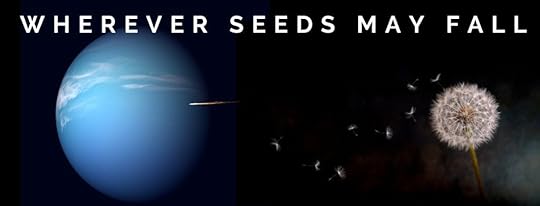
December 10, 2020
Which is better? The book or movie?
Which is better? The book or the movie of the book?
Most movies and television series are made-for-the-screen, but occasionally books are converted into movies/series and the inevitable question arises—which is better?
A couple of years ago, this was an easy question to answer—the book. But producers and directors have lifted their game and an interesting trend has emerged. Now, books are often considered “source material.” Rather than trying to translate from one medium to another verbatim, the focus is on developing the material and, as an author, I like this approach.
Books are generally the domain of a single writer whereas movie/television productions have writing rooms. There are pros and cons to each approach. From what I’ve seen, combining the two approaches magnifies the pros and eliminates the cons.
As a writer working on my own, I have the advantage of an unlimited special effects budget and can avoid too many cooks spoiling the broth (I’m looking at you, Prometheus), but the disadvantage is an extra set of eyes looking for plot holes or inconsistencies.
In a writing room, there’s a danger of too many angles and plot-lines being shoehorned into a story “just because,” but when working with an existing story, the writing room can explore untapped veins of gold within a novel and expand upon the source material.

A good example of this is The Expanse (a television series built on a best selling series of science fiction novels). The James S. A. Corey duo are also involved with the screenwriting (which is unusual), but they’ve been open to expanding concepts from the books.
For example, one of the most fascinating characters in the series is the UN’s Chrisjen Avasarala. She appears in the second novel, Caliban’s War, but is moved up to the first series of the show because of her importance to the themes being developed. To me, her character arc is a good example of expanding the source material. The acting is sublime and her story displays how political power is wielded effectively.

Netflix has been revolutionary, leading to Amazon Prime, Apple TV, etc. Not only have these companies spearheaded online video streaming services, they’ve made strategic decisions to pour some serious cash into developing their offerings. It used to be that movies were far superior to television, but not any more. These days, movies pale in comparison to a well-developed online series because the series has the advantage of time, allowing for character development on screen to finally be on par with what is possible in a book.
Oh, and for the record, I’m pro-binge over weekly releases. I get why streaming services go for the weekly release (to keep people subscribing), but the binge allows for some serious story immersion and I think there’s enough diverse content to keep people subscribing anyway.
For me, the future of collaboration between books and video is bright. I’d like to think we can have our cake and eat it too.
August 23, 2020
Is there life in outer space?
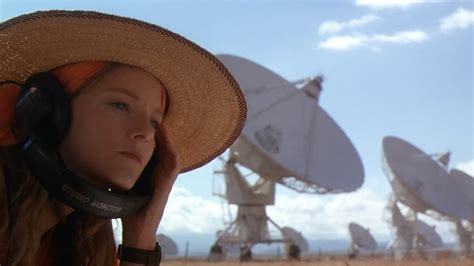
The answer should be obvious
Yes!
Of course there’s life in space—that’s where Earth is!
Our planet is one teeny, tiny corner of an astonishingly vast universe. This might sound like a cheat/cheap answer, but it’s genuine. Earth is absolute proof life can thrive on an obscure planet in deep space!
We’re all astronauts on Starship Earth!
From our anthropomorphic self-centered perspective, we like to make a distinction between Earth and space but, in reality, no such distinction actually exists. Earth is just another planet in orbit around a rather ordinary star within a roughly average galaxy!
We are proof life can thrive in space for billions of years!
“Ah, but Earth is special. Earth is habitable,” some may say, but is it? Really?
Habitable is a matter of perspective. Earth is habitable for us but hostile for the organisms that first arose here billions of years ago! The cyanobacteria that produced most of the oxygen caused the first mass extinction!!!

When a species positions an entire planet
Could life thrive here?
Because this is roughly what Earth looked like during the Hadean era!

How about here? Could life flourish here?
Because this is what Earth looked like several times over the past 4.5 billion years!

The cyanobacteria that produced most of the oxygen caused the first mass extinction during what’s called The Great Oxidation Event 2.4 billion years ago. Without that, there wouldn’t be any oxygen for us to breathe today!
Earth is barely habitable. If you look at where Earth sits, it’s right on the inner edge of the habitable zone. Were it not for our atmosphere trapping heat, Earth’s seas would be frozen like Europa (we went through several snowball Earth periods!)
Without naturally occurring greenhouse gases, Earth’s average temperature would be near 0°F (or -18°C). Basically, we live on what would otherwise be a deep freezer.
Earth barely makes it into the habitable zone!
Rather than being the ideal goldilocks planet, sitting right in the sweet spot, Earth BECAME habitable! Microbes terraformed Earth. Life itself made Earth the oasis it is today!

If microbial life can do that here, why can’t it do the same elsewhere? Given billions of years like it had on Earth, the odds are, it can!
And there’s a good chance that, with the launch of @NASA @JWSTObserver in 2021 we’ll be able to detect life on other planets!
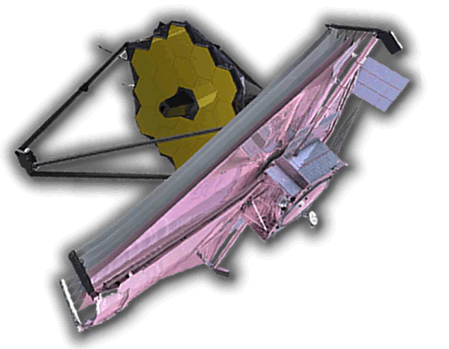
https://jwst.nasa.gov/content/science/origins.html
• • •
August 14, 2020
Our Greatest Strength
America won the Second World War on the back of its manufacturing.
Although wars require soldiers and weapons, ultimately, wars are won by endurance. When it came to World War II, the US economy outproduced its enemies. A single Chrysler factory in Detroit produced more tanks than the entire Third Reich. Ford’s Willow Run Plant rolled a B-24 Liberator bomber off its production line every two hours.
[image error]
B24 Liberator
Under normal circumstances, Liberty class cargo ships took 70 days to build, but the US got that down to four and a half days and, across all its shipyards, produced three ships a day! Not only was this a marvel of manufacturing prowess, it was a staggering logistical accomplishment.
The Germans never stood a chance, particularly once Allied bombers started hitting their factories, crippling their manufacturing.
And this brings up an interesting point. For all our faults, the greatest strength of our modern global economy is mass production. It’s what’s made smart phones like Androids and iPhones ubiquitous. Economies of scale have made modern life possible, but this transformation is yet to click for space exploration.
[image error]
Firestone Tire & Rubber Co. in Akron, Ohio. Imagine if these were deep space probes.
When it comes to NASA, there were some economies with 11 Apollo missions (Apollo 7 – 17), the Apollo/Soyuz mission and Skylab all using Saturn V and the Apollo assembly, but most capsules (and particularly the LEMs) were based on incremental improvements.
[image error]
Apollo assembly line
The Space Shuttle was supposed to be a highly reusable vehicle that could be copied to build a fleet, but in practice, no two shuttles were the same. Astronaut Mike Mullane argues in his book Riding Rockets that the shuttle was only ever experimental. Although public opinion was that shuttle flights were akin to a fancy 747, they never achieved anything like that level of reliability and efficiency or safety.
NASA has had some success with repeating designs, like Voyager 1 & 2, Viking 1 & 2 and Mars Curiosity/Perseverance (which both use the same chassis), but the bespoke nature of most missions mean there’s no opportunity to leverage the efficiency of mass production. With rockets, yes, but not with probes.
[image error]
You wouldn’t build just one car
Imagine if just a fraction of the manufacturing prowess we have behind Toyota, Hyundai, Ford, BMW, Mercedes or Boeing and Airbus was applied to building space probes.
For better or for worse (and a lot of astronomers would argue for worse), SpaceX have come closest to mass manufacturing economies of scale with their Starlink fleet of satellites. By building the same satellite thousands of times, they can drive down individual costs and launch a comprehensive space-based internet network.
Are companies like Iridium and SpaceX onto something with their mass produced satellites? Could scientific payloads benefit from the same approach?
[image error]
Starlink satellites queued ready for deployment
When it comes to the exploration of the moons in the outer solar system, there’s a case to be made for a single, repeatable, ubiquitous design that allows for landing, gathering and returning samples. The cost of such a mission is so astonishingly prohibitive and the time scales over which it must be conducted so long that it makes sense to use mass manufacturing to lower the per-mission cost and increase the effectiveness.
[image error]
NASA’s Europa Clipper
NASA’s Europa Clipper is a prelude to a lander, but what if we built clippers for Europa around Jupiter and Enceladus around Saturn and Triton around Neptune? Same design. Three points of application.
What if, instead of building a lander, driller, sample return for Europa (something that won’t happen until 2040 at the earliest), we built ten of them? Or twenty? Or a hundred? Who says we only need one on Europa? Can you imagine if we took that approach to exploring Antartica?
The advent of SpaceX, Blue Origin and Rocket Lab is heralding a new era in orbit around Earth as they employ mass manufacturing techniques and 3D printing, but it’s just the start. If we can apply the same approach to building space probes perhaps we can drive down costs to properly explore the solar system.
When are we going to build the Toyota of space probes?
[image error]
Enceladus may harbor life in its subsurface ocean
August 13, 2020
Myths and Fables
Although a post about religion might seem unusual for a blog about science and science fiction, it is relevant as the majority of people on Earth believe in one God or another.
I’m not religious, but I respect those that find comfort in their beliefs and act with kindness and compassion toward others, making the world a better, brighter place. We need more love, not less.
Religious beliefs, though, should be in harmony with science. If they’re not, we’ve got a serious problem.
[image error]
We seem more concern about past beliefs than current advances or the future
Religious beliefs that are based on a literal interpretation of the Bible or the Koran are anti-science and that makes them potentially harmful. How remarkable that the Bible itself warns people to be careful about what they believe.
But refuse and avoid irreverent legends and silly myths — I Timothy 4:7
How does religion become anti-science? By embracing fables as though they were true.
Noah’s ark is the classic example.
[image error]
If the Bible is literally true, then Noah gathered at least two of every kind of animal (and in some cases seven pairs of ceremonially clean animals) onto a massive boat that would ride the waves of a flood for the best part of a year.
Noah’s ark is estimated to contain 1.5 million cubic feet. Given there are roughly 6 million land dwelling species (at the lower end of estimates), there simply wouldn’t be enough space for two of every kind (you’d have to fit them into spaces approximately 1.5 inches squared, or in cubes around 4 centimeters each, which is absurd).
Noah’s ark is a religious story that’s simply not true. It’s a fable—a legend. It’s precisely what the Apostle Paul warned us about.
For anyone that’s still not convinced, how did the flightless Kiwi from New Zealand get to Noah’s Ark?
Or the Australian Koala?
[image error]
Can you imagine this guy walking all the way to the Middle East?
Koalas average a foraging distance of about 8 km per month. Given the distance between Australia and Israel is roughly 12,000km, if we ignore the oceans for a moment, it would take a koala 125 years to travel that far! Given Koalas only live for 12-15 years, this would have been a multi-generational journey for our marsupial friends. Oh, and after the flood, they need to get back to Australia, so it’s a minimum 250 year round trip. Oh, and they only eat eucalyptus leaves, which aren’t found anywhere along the way.
Clearly, Noah’s ark is one of the “silly myths” described in I Timothy.
Why is this important? Why does it matter?
Actually, it’s quite important because as soon as critical thinking is suspended to embrace a belief like Noah’s ark or the creation myth in Genesis, where all the animals are created in just a few days, someone is primed to dismiss good science, believing in myths rather than truth.
Noah’s ark might be a silly example, but what happens when it comes to beliefs/fears about vaccinations or 5G cellular towers, equal rights or covid-19?
How can someone that believes in Noah’s ark practice the critical thinking required to get to the truth about more important subjects? The answer is, they can’t. And this leaves them vulnerable to all sorts of wild, fanciful conspiracy theories.
Critical thinking is essential to our survival. I really don’t care whether someone believes in God or not, or which God they may believe in, what I care about is can they make their own judgements about important aspects of life? Or are they at the mercy of some supposed higher authority telling them what they should do?
Being honest with our beliefs is important.
We should question assumptions.
We should not blindly accept fallacies.
[image error]
TL;DR — Don’t surrender your intellect to foolish notions because of religious peer pressure.
[image error]
April 14, 2020
#ReadAtHome
COVID-19 is heartbreaking, ravaging our world and killing tens of thousands. As there’s no vaccine, the only effective strategy to contain its exponential growth is to self-isolate and stay at home.
There’s not much a science fiction writer can do beyond encourage people to listen to the experts and wash their hands, but I thought I could help with a #StayHome #ReadAtHome campaign.
[image error]
Not my library, but oh, how I wish…
Here’s how it works… for the next 40 days, I’m making one of my novels available for free on Amazon every 2 days! Each ebook will remain free for 5 days. Here’s the schedule. Hopefully, that’ll give you plenty to #ReadAtHome.
Novel
Teaser
Weekday
Starts
Ends
The Curious Case of the Hounds of Hell
Sherlock Holmes undertakes his most challenging case yet
Thursday
April 16th
April 20th
Mister Fluffy Bunny
WARNING: Contains violence, drug references and cute stuffed toys.
Saturday
April 18th
April 22nd
Alien Space Tentacle Porn
Read the reviews, then read the book
Monday
April 20th
April 24th
Shadows
For lovers of Hugh Howey’s WOOL series
Wednesday
April 22nd
April 26th
Anomaly
First Contact turns a New York street upside down
Friday
April 24th
April 28th
Nosferatu
Bram Stoker’s Dracula reimagined
Sunday
April 26th
April 30th
Feedback
Time travel inevitably leads to feedback loops
Tuesday
April 28th
May 2nd
What We Left Behind
Zombies have met their match in at teenaged girl called Hazel
Thursday
April 30th
All Our Tomorrows
Hazel is back to clean up Zee once and for all
Saturday
May 2nd
Road to Hell
Loyalty is a disease
Monday
May 4th
Starship Mine
It’s the journey we all take in life
Wednesday
May 6th
Welcome to the Occupied States of America
What can a disabled teen do when faced with ravenous alien monsters?
Friday
May 8th
Monsters
When reading is outlawed
Sunday
May 10th
Little Green Men
Be careful what you wish for
Tuesday
May 12th
My Sweet Satan
When first contact gets a little too close
Thursday
May 14th
Losing Mars
A rescue mission conducted 400 million miles from home
Saturday
May 16th
Maestrom
What happens when parallel worlds collide?
Monday
May 18th
Hello World
A decade’s worth of short stories in one anthology
Wednesday
May 20th
Xenophobia
What happens when first contact interrupts a civil war?
Friday
May 22nd
But the Stars
Who do you trust?
Sunday
May 24th
Please feel free to share this on Twitter, Facebook, Instagram, etc.
If you don’t want to miss any of these, subscribe to my newsletter as I’ll be sending out reminders.
If you’re curious as to why some books don’t have an end date it’s because there’s a limit on how far I can schedule promotions on Amazon, so these will get filled in as each date approaches.
I’d like to encourage other authors to join the #ReadAtHome challenge.
#StaySafe
March 30, 2020
Book Review: But The Stars by Peter Cawdron
Here’s a great review of my latest novel But the Stars by The Indie Athenaeum
Book Title: But The Stars
Author: Peter Cawdron
Publication Date: March 27, 2020
Available on: Amazon as an eBook and as a paperback
Indie Athenaeum Rating: 5 out of 5 Stars
It’s the 22nd century and the crew of their starship Acheron is in orbit, exploring the distant ice world of P4 around the star WISE 5571. After establishing a research station, they’re there for several months and along the way, they noticed that they were not alone and an unusual life form was there!
In an effort to escape the planet and its 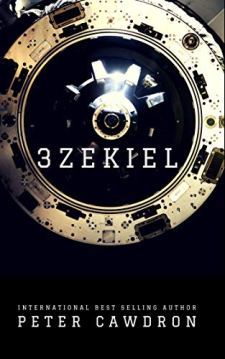 inhabitants, things go sideways and their lives are at risk as the research station begins falling apart around them! Trying to escape, Dante, the ship’s flight surgeon, won’t leave her friends behind. But tentacles slither out of the darkness and grab her legs! Falling unconscious, she awakens on her ship like nothing…
inhabitants, things go sideways and their lives are at risk as the research station begins falling apart around them! Trying to escape, Dante, the ship’s flight surgeon, won’t leave her friends behind. But tentacles slither out of the darkness and grab her legs! Falling unconscious, she awakens on her ship like nothing…
View original post 1,201 more words
November 15, 2019
Beyond the Known
Dr. Andrew Rader (from MIT, specializing in long-duration spaceflight) is a SpaceX mission manager, scientist, science fiction aficionado and futurist. He has a keen eye for the past and recognizes how history shapes our future. He’s the author of several children’s books that seek to inspire the next generation of scientists and explorers and has just released something for us adults—Beyond the Known: How Exploration Created the Modern World and Will Take Us to the Stars.
I had the privilege of reading an early draft of the book and loved the way it followed the history of exploration from our humble beginnings in Africa to the migration of the Polynesians, the exploits of the Egyptians, the early sea-voyages of the Chinese through to the Romans, Vikings and Europeans.
Dr. Rader examines the motivations and ramifications of vastly different cultures as they venture out into the world. He looks at how they waxed or waned based on their desire to explore. For me, that was the crux of the book—that for all our faults, exploration opens up new horizons, and not just in terms of trade but in ideas and ethics. There’s a twisted dichotomy to exploration. On one hand, the exploitation of others through cruelty and greed is the low point, but it also provides a melting pot for diverse thinking, which provokes change. It seems the allure of the horizon has always beckoned us on, calling to us, promising of a bright future.
Curiosity is the engine that drives exploration. If you’ve read Darwin’s On the Origin of Species, you’ll know most of the examples are of species found in England. From the breeding of pigeons to ants fighting on the side of the path next to his cottage to how weeds compete with each other to fill an empty plot of dirt. Darwin may have drawn on local observations, but it was the voyage of the Beagle and his exploration of the Galapagos that set his mind alight. Exploration allowed him to see what had been staring him in the face all along.
For me, the defining criteria of a great book isn’t what lies on each individual page, it’s whether it makes me think. A five star book is one that has me mulling over ideas for days and weeks to come, and Beyond the Known does that. It leaves you with a sense of awe at how far we’ve come and excitement for the next steps.
In Beyond the Known, Dr. Rader traces our growth as a species reaching for the stars, and makes the case that our past allows us to chart the future. One day, we’ll stand on Mars and soar out toward the stars, taking all we have learned with us. Exploration shapes us, it defines us. There’s something primeval about our desire to learn—whether that’s a child on a beach looking in rock pools or the Juno probe in orbit around Jupiter, we seek because we want to learn, and we’re better for that journey.
Beyond the Known is available in ebook, paperback, hardback (complete with maps and illustrations) and (I highly recommend the) audiobook.
If you’re looking for a great read over Christmas, check out Beyond the Known.
[image error]
Beyond the Known
August 31, 2019
Don’t shoot yourself in the back!
Dr. Phil Metzger is a Planetary scientist at the University of Central Florida and CoFounder of NASA KSC SwampWorks. In a recent tweet thread he talked about the danger of dust being kicked up when landing on the Moon.
Dust? Really? So a spacecraft kicks up a little dust while landing. What’s the big deal? As you’ll see in this article. Something as trivial as dust can be problematic for future missions.
[image error]SpaceX Starhopper performs a successful take off and landing
Picture credit: BBC article on SpaceX
If you look at any rocket launch or the recent test of the SpaceX Starhopper there is ALWAYS dust, sand, dirt and rock kicked up, mixed with exhaust fumes and water vapor, forming impressive clouds.
[image error]Falcon Heavy launch.
Picture credit: SpaceX
Imagine standing down there, just slightly off to one side as the launch exhaust rushes at you. Madness, right? Ah, yeah… that’s precisely where Dr. Metzger’s research picks up. You see, on Earth, we have a thick, dense atmosphere, so the rush of the exhaust quickly dissipates as it runs into opposition from the atmosphere, billowing into those iconic clouds. Not so on the moon.
Dr. Metzger and his team spent considerable time analysing the footage of the Apollo lunar landings, looking at the dust and debris being kicked up. In this image, a rock the size of a fist is accelerated to 15 meters per second (about 35 miles per hour)
[image error]Rocks being propelled by the Apollo Lunar Lander
Picture credit: NASA with annotation by Dr. Metzger
As they looked closer, Dr. Metzger’s team noticed dust trails forming behind rocks embedded in the surface of the Moon. In essence, these rocks were being sandblasted, slowly stripped away by the grit kicked up by the exhaust.
[image error]Dust trails forming behind rocks as they’re eroded by the exhaust
Picture credit: NASA with annotations by Dr. Metzger
What the team realized was there was something in between the easily visible rocks and the dust trails, and that was sand. Rocks were clearly visible, tumbling in the videos. Dust formed trails that were easy to see, but the fine grains of sand were essentially invisible, although their effect was apparent, causing rapid erosion.
When they calculated the speed of these various classes of ejecta, they were surprised to see dust and sand exceeded the escape velocity of the Moon.
[image error]
Unlike on Earth, where the exhaust gases and dust mix with the atmosphere, billowing into clouds as they slow down, there’s no such resistance on the Moon. Being in a vacuum, once set in motion, this ejecta keeps going until it hits something.
[image error]Ejecta trajectory
Picture credit: Dr. Metzger
The image above is a simplification, but it highlights a surprising problem when it comes to Lunar missions. You can shoot yourself in the back!
Dr. Metzger points out that there are FOUR points at which the hyper-velocity ejecta could impact a lunar orbiter. Remember, the lander is kicking out debris in all directions so (in our illustration above), some goes left, some goes right and then crosses the orbit twice (while outbound and then again when inbound).
These calculations were done for the Apollo missions. Even back then, with a lightweight lander, ejecta could be propelled off the surface into orbit. Not only did dust, grit and sand get into orbit, it went well above the altitude of the CSM (Command Service Module) waiting in orbit.
[image error]Apollo CSM
Picture credit: NASA
Now space is big. Dr. Metzger’s diagram is a generalisation to make the point. The likelihood of a direct impact is tiny as the Moon’s gravitational field is “lumpy” (for lack of a better word), so the probability of grit and dust returning to exactly the same point is low, but it is NOT zero. It could come down anywhere within a hundred miles of the original landing zone after circling the Moon.
As bigger craft land more often, the problem gets worse. (Bigger landing craft will throw off bigger debris). If we establish a surface base, the impact of micro-meteors may very well originate from our own landing craft!
What would the damage be to orbiting spacecraft or astronauts on the surface? Imagine standing in the way when the craft originally came down, as that grit and rock won’t have lost any of its momentum.
Could some of these artificial micro-meteors puncture a spacesuit? They would probably get through some layers at least. If they hit a spacecraft, the damage will depend on the size/speed, but several years ago, the shuttle was hit by a fleck of paint and the result looked like a bullet had struck.
[image error]Tiny bits of rock and sand can ruin your day in space
Picture credit: NASA
As we return to the Moon, the research of planetary scientists like Dr. Metzger will allow us to understand the risks and plan accordingly so we can avoid shooting ourselves in the back.
You can read the original thread by Dr. Metzger on Twitter.




